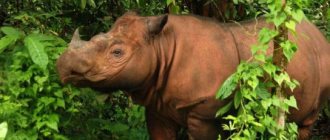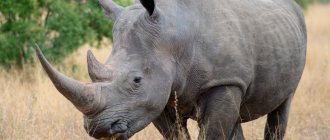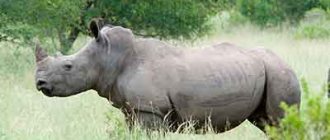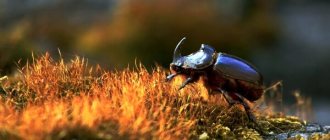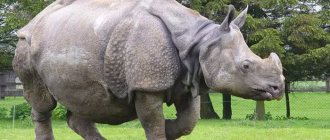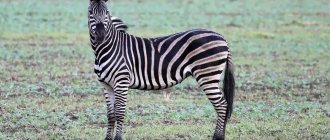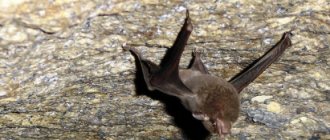The rhinoceros is the calling card of Africa. It is not for nothing that he was included in the top five animals that in the old days were the most treasured safari trophies. It is interesting that this giant has poor eyesight, but given its power and enormous size, this does not matter much for the animal.
Many wildlife lovers are interested in what a rhinoceros is: a predator or a herbivore? What kind of lifestyle does he lead? We will try to answer these questions in the article.
Features and habitat of the rhinoceros
There’s probably no point in arguing that the rhinoceros is one of the largest animals inhabiting our planet. The world knows of only five living species of odd-toed ungulates - these are black and white rhinoceroses, Javan, Indian and Sumatran. Representatives of Asian species differ from their African relatives in that they have only one horn, while others have two.
The white rhinoceros, living in the savannas of the African continent, is the leader in terms of numbers compared to its black counterpart living there. Apart from this, there are no other distinctive characteristics that would be very different between the two species.
It is interesting that the name black rhinoceros , as well as the nickname white animal, are very conventional. Because the shade of the animal’s skin depends on the color palette of the soil covering the part of the earth where the rhinoceroses found their shelter. Rolling in the mud is a favorite pastime of rhinoceroses; they stain their skin with mud, drying in the sun, which gives one or another shade to the skin.
Rhinoceroses are animals of considerable size. With its impressive weight of 2 to 4 tons and a length reaching about 3 meters or more, its height is only 1.5 meters. Such parameters give the right to call the rhinoceros a squat animal.
Pictured is a white rhinoceros
As previously mentioned, the head of a rhinoceros is decorated with horns. For example, in Africa , in particular in Zambia, these unique animals have three, and sometimes five, horny processes.
The record for the length of these processes belongs to white rhinoceroses - its length, according to experts, can reach one and a half meters. If we describe the Sumatran rhinoceros in a nutshell, then it is reliably known that this is the most ancient species of those who have survived to this day.
Its body is covered with hard short hairs, there are incisors, and on the front of the head there are two horns of 25-30 cm each, and the third horn is a pitiful semblance of a horn and can be called an elevation and nothing more.
Pictured is a Sumatran rhinoceros
As they say, God did not offend the rhinoceros with his physique. Nature has endowed him with a very massive body, a neck of the same shape, a large rounded butt, and thick but short limbs.
A rhinoceros has three toes on its feet and each of them ends in a small hoof, this is how they differ from horses. But the animal’s tail was naturally small, like a donkey’s, and even has the same tassel.
Looking at a photo of a rhinoceros , you can immediately understand what a powerful and strong animal it is. The skin is wrinkled, incredibly thick and quite rough, but this does not prevent them from forming folds on the animal’s body and this makes the rhinoceros look like an animal dressed in armor.
Animals have no fur. Only the edges of the ears and the tuft of the tail are covered with gray fur. We remind you that this does not apply to Sumatran rhinos.
The sense organs are developed in different ways - the sense of smell is perfectly developed, but hearing and especially vision are not sharp enough and therefore play a secondary role in the life of the animal.
This is interesting: What is the life expectancy of a wolf in the wild?
Reproduction and raising of young
Female rhinos are ready to reproduce when they reach 4 years of age. Males mature more slowly and become sexually mature only at the 7th year of their life. But only a rhinoceros that has its own territory can leave its descendants on earth. So mature males have to wait another 2-3 years before they acquire personal possessions, which serve as proof to the pachyderm ladies that they are worthy of fathering their future cubs.
Mating season
Rhinos do not have a specific breeding season; females come into estrus every 1.5-2 months, and theoretically, they are capable of mating all year round. But for almost all varieties, the mating season falls in the spring months, coinciding with the rainy season in the habitats of these animals.
Male rhinos engage in real battles for the right to mate with a female
Females signal their readiness to become mothers by leaving excrement marks containing secretions from their gonads. It is by this smell that adult males find their potential darlings. But one female can be followed by several excited gentlemen, and then they have to dispute their right to possess the lady of their heart in a fair fight.
Battles between male rhinoceroses are more of a ritual nature, and very rarely lead to death; they usually end when one of the opponents is knocked to the ground, which automatically means defeat. Indeed, despite the fact that each of them is armed with a sharp horn, in battle against each other the rhinoceroses almost never use it, but push the competitor with their massive body. But in the heat of battle, males can sometimes wound each other with their deadly weapons, and a rhinoceros can even die, pierced by the horn of an opponent.
The winner does not have to enjoy his triumph for long, because he still has another battle, this time with a female. Yes, thick-skinned ladies are very capricious, and they expect the male to prove that he is the strongest and most worthy contender. For almost 2 weeks the female does not allow her boyfriend to approach her, and in general behaves quite aggressively towards him. But, in the end, the male’s persistence and determination win her heart, and the couple in love spends several days together, after which each partner goes in different directions, never to meet again.
What do rhinoceroses eat?
All species of rhinoceroses lead a crepuscular lifestyle. They come out to graze at sunset. Each species has its own food preferences, but, as a rule, they feed on young trees, their fruits and leaves. One adult animal consumes about 50 kilograms of vegetation per day. Preference is given to the Euphorbiaceae or Rubiaceae family.
To get to one or another type of plant growing at higher elevations, the rhinoceros leans its weight onto the tree trunk. Some species change habitats quite often due to lack of vegetation.
Rhinoceros - a blind giant
Content:
The rhinoceros is one of the iconic animals of Africa, a kind of calling card of the “dark continent”; it is not for nothing that it is one of the “Big Five of Africa” along with the elephant, buffalo, lion and leopard, the same five animals that in the old days were the most honorable trophies hunting safaris. The rhinoceros also has rather poor eyesight, but as they say, given his size and power, this is no longer his problem.
Character and lifestyle of the rhinoceros
The character of the rhinoceros is contradictory. He is suddenly meek and calm, then suddenly becomes furious and militant. Probably, the massive size, inspiring fear, and a kind of myopia make it possible to feel completely safe.
In fact, the animals of the savannah, besides humans, have enemies you can count on one hand - elephants, tigers and sometimes angry buffaloes. The tiger, however, does not pose a danger to an adult, but he is not averse to feasting on the meat of a baby rhinoceros. Therefore, when the right moment comes, the tiger tries to steal the young offspring from under the nose of the gaping mother.
Man is the most terrible enemy of the rhinoceros. The reason for the extermination of animals lies in their horns, which have a high price in certain circles. Even in ancient times, people believed that the horn of an animal could bring good luck and grant the owner immortality. Traditional healers used the unique properties of these horny processes in alternative medicine.
Having finished this lyrical digression, let me move on to a further description of the rhinoceros’s lifestyle. So, thanks to its developed sense of smell, an animal can hear a person from a distance of 30 or a little more meters.
As soon as the animal senses danger, it will not wait to meet the enemy, but will run away, which, in general, is not without logic and obeys the laws of self-preservation. The rhinoceros can run quickly.
His speed is much greater than that of the Olympic champion and is 30 km/h. Scientists have also calculated the speed of a running rhinoceros when it is furious and claim that it can be cruising - 50 km/h. Agree, it's impressive!
Rhinos swim as well as they run. However, the rhinoceros prefers a leisurely lifestyle and therefore spends most of its life in reservoirs, basking in the mud under the gentle warm rays of the sun. True, the peak of activity in animals is observed at night. Rhinoceroses dream while lying down, with their muzzle buried in the dirt and all their limbs tucked under them.
the Asian rhinoceros a herd animal , because it prefers to lead a solitary lifestyle. Sometimes, people encounter two or three animals in a compartment, but these are mostly mother and cubs. But African relatives get along in small groups, numbering from 3 to 15 individuals.
The rhinoceros marks the boundaries of its property with urine or makes marks with droppings. True, experts believe that piles of droppings are not boundary markers, but a kind of reference data. A passing rhinoceros leaves landmarks for its follower, which indicate when and in what direction the relative moved.
The animal world where rhinoceroses live is very diverse, but this animal does not bother its neighbors, and among the birds they have comrades. So, for example, birds belonging to the starling species are constantly close to this formidable animal.
They constantly jump around the body of the rhinoceros and every now and then are engaged in pulling bloodthirsty ticks out of the folds. Apparently, when they succeed, an unpleasant pain occurs, because the animal jumps up and begins to snort, but then calms down and flops back into the swamp.
Lifestyle of rhinoceroses in the wild
These mammals often live alone, without forming herds. Only white rhinoceroses can gather in small groups, and females with cubs of all species exist together for some time. Females and males of rhinoceroses are together only during mating. Despite such a love of solitude, they have friends in nature. These are wolves, or buffalo starlings (lat. Buphagus), small birds that constantly accompany not only rhinoceroses, but also zebras, giraffes, elephants, buffaloes, and wildebeests. The birds peck insects and ticks from the backs of mammals, and also scream to warn them of approaching danger. From the Swahili language, the name of these birds, askari wa kifaru, is translated as “protectors of rhinoceroses.” Turtles, which wait for the animals in their mud baths, also like to eat ticks from the skin of rhinoceroses.
Photo credit: Marc Samsom, CC BY 2.0
Rhinoceroses strictly guard their territory. The pasture area and the reservoir on it are for the “personal use” of one individual. Over the years, animals have trodden their paths on the territory and set up places for taking mud baths. And African rhinoceroses also organize separate latrines. Over a long period of time, impressive piles of manure are formed in them, which serve as an aromatic landmark and do not allow them to lose their territory. Rhinos mark their grounds not only with dung: old males mark areas where they often graze with odorous marks, spraying urine on the grass and bushes.
Black rhinoceroses are more often active early in the morning, as well as at dusk and at night: at this time of day they try to get enough, and it is very difficult for such giants to do this. During the day, the rhinoceros sleeps in the shade, lying on its stomach or side, or spends time lying in the mud. These bumpkins sleep very soundly, during which they forget about any danger. At this time, you can easily sneak up on them and even grab them by the tail. Other rhino species are active both during the day and at night.
Photo credit: International Rhino Foundation, CC BY 2.0
Rhinoceroses are cautious animals: they try to stay away from people, but if they feel threatened, they actively defend themselves, attacking first. Rhinoceroses run at a maximum speed of 40-48 km/h, but not for long. Black rhinoceroses are more hot-tempered, they attack quickly, and it is impossible to stop such a colossus. Their white counterparts are more peaceful, and human-fed cubs become completely tame and are happy to communicate with people at any opportunity. Mature females even allow themselves to be milked.
Rhinoceroses are quite noisy animals: they snort, sniffle, purr, squeal, and moo. Grunting and even neighing can be heard when animals graze peacefully. Disturbed mammals make sounds similar to loud snoring. Females grunt, calling the cubs to them, who squeal, having lost sight of their mother. Wounded and captured rhinoceroses roar loudly. And during the rut (breeding period), a whistle is heard from the females.
Most of these mammals cannot swim at all, and rivers become insurmountable obstacles for them. Indian and Sumatran rhinoceroses swim well across bodies of water.
Nutrition
It’s hard to believe, but the giant beast doesn’t need meat at all to feed itself. Their diet consists only of plant foods. Moreover, white rhinoceroses eat grass to a greater extent, because their lips are folded this way - the upper one is long and flat.
That's why they nibble on greens like cows. But in black rhinoceroses, the upper lip is narrowed and pointed, and with its help, the animal easily tears leaves from branches.
African animals tear off small bushes and huge thickets of even thorny grass straight from the roots and chew them without difficulty. And there were cases when rhinoceroses wandered into farmer’s plantations, then a real disaster happened because they ate everything that could be eaten, trampled down the rest, leaving whole ruts behind.
To saturate the body, the animal needs to eat at least seventy kilograms of grass. They have such strong stomachs that even when they ate poisonous milkweed, it did not in any way affect the health of the animal.
Water also plays an important role in the body of a hero. In hot weather, he needs to drink more than one hundred and fifty liters of fluid per day. rhinoceros animal must drink at least fifty liters of water
Description, structure, characteristics
The Latin name of the rhinoceros - Rhinocerotidae, is essentially identical to ours, since “Rhino” means “nose”, and “ceros” is a horn, resulting in “rhinoceros”, this name very aptly characterizes this animal, because the large horn on the nose, growing from The nasal bone is an integral attribute of all decent rhinoceroses (however, not decent ones either).
And also the rhinoceros, the largest land mammal after the elephant - the length of the rhinoceros is from 2 to 5 meters, with a height of 1-3 meters and a weight of 1 to 3.6 tons.
The colors of rhinoceroses depend on their species; in fact, at first glance, it seems that the names of rhinoceros species actually come from their colors: white rhinoceros, black rhinoceros. But here not everything is so obvious and unambiguous, the fact is that the real skin color of both white and black rhinoceros is the same - gray-brown, but due to the fact that these rhinoceroses like to wallow in the ground of different colors, which colors them different colors, and so did their names.
The head of a rhinoceros is long and narrow, with a steeply sloping forehead. Between the nasal bones and the forehead there is a concavity, somewhat similar to a saddle. The small eyes of a rhinoceros with brown or black pupils and their size look very contrasting against the background of their large head. As we already mentioned at the beginning, rhinoceroses’ eyesight is not important; they are only able to see moving objects from a distance of no more than 30 meters. In addition, the fact that their eyes are located on the sides does not give them the opportunity to properly examine this or that object; they see it first with one eye, then with the other.
But rhinoceroses’ sense of smell, on the contrary, is well developed, and it is on this that they rely most. Interestingly, the volume of the nasal cavity in rhinoceroses is larger than the volume of their brain. The hearing of these giants is also well developed; the ears of rhinoceroses are like tubes that constantly rotate, picking up even faint sounds.
The lips of rhinoceroses are straight and awkward, with the exception of the Indian and black rhinoceroses, which have a movable lower lip. Also, all rhinoceroses have 7 molars in their dental system, which wear out greatly with age; in addition to teeth, Asian rhinoceroses have incisors, which are absent in African rhinoceroses.
All rhinoceroses have thick skin, which is almost completely devoid of hair. The exception here is the modern Sumatran rhinoceros, whose skin is still covered with brown hair, and the woolly rhinoceros that once lived in our latitudes, which, together with the same woolly mammoth, unfortunately, has not survived to this day.
The legs of a rhinoceros are heavy and massive, each foot has three hooves, as a result of which it is very easy to recognize by the rhinoceros's tracks where these giants walked.
How long does a rhinoceros live?
These large animals live a long time: African rhinoceroses in natural conditions live on average up to 40 years, and in zoos their life expectancy increases to 50 years. Recognized long-livers in the family are Javan and Indian rhinoceroses, living up to 70 years.
We hope that now you know the answer to the question: is a rhinoceros a predator or a herbivore?
Source
This is interesting: What snakes lay eggs?
Video
And finally, an interesting video about crazy rhino attacks caught on camera.
Author: Pavel Chaika, editor-in-chief of Poznavaika magazine
When writing the article, I tried to make it as interesting, useful and high-quality as possible. I would be grateful for any feedback and constructive criticism in the form of comments on the article. You can also write your wish/question/suggestion to my email [email protected] or Facebook, with respect, the author.
Author page
This article is available in English - Rhino (Rhinoceros).
№11
Just 100 years ago there were about 500,000 rhinoceroses in the world. Today their number has dropped to 30,000. A serious decline in the population is caused by poaching.
Absolutely all 5 species are endangered, but the most vulnerable are the following species:
- Javanese.
- Sumatran.
- Black.
Today, only 60 Javan, about 100 Sumatran and approximately 5,500 black rhinos remain in the wild.
Where does the rhinoceros live?
In our time, from the once large family, only 5 species of rhinoceroses have survived, belonging to 4 genera; all of them have become rare and are protected by people from people. Below are data from the International Union for Conservation of Nature on the number of these animals (data verified on January 5, 2022).
Three species of rhinoceroses live in Southeast Asia:
- The most numerous of them, the Indian rhinoceros (lat. Rhinoceros unicornis), lives in India and Nepal, inhabiting floodplain meadows. The species is vulnerable; the number of adult individuals in May 2007 was 2575 units. 378 of them live in Nepal and approximately 2,200 in India. The rhinoceros is listed in the International Red Book.
- The situation is worse with Sumatran rhinoceroses (lat. Dicerorhinus sumatrensis), the number of which does not exceed 275 adult individuals. They are found on the island of Sumatra (in Indonesia) and in Malaysia, settling in swampy savannas and mountain rain forests. Possibly, the habitat of several individuals includes the north of Myanmar, the state of Sarawak in Malaysia, and the island of Kalimantan (Borneo) in Indonesia. The species is endangered and is listed in the International Red Book.
- The Javan rhinoceros (lat. Rhinoceros sondaicus) is in a particularly deplorable state: the mammal can only be found on the island of Java in reserves specially created for its conservation. The Javanese lives in flat clearings of constantly humid tropical forests, in thickets of bushes and grass. The animals are on the verge of extinction, and their number does not exceed 50 individuals. The species is listed in the International Red Book.
Two species of rhinoceroses live in Africa:
- The white rhinoceros (lat. Ceratotherium simum) lives in the Republic of South Africa, was introduced to Zambia, and has also been reintroduced to Botswana, Kenya, Mozambique, Namibia, Swaziland, Uganda, and Zimbabwe. Inhabits dry savannas. Mammals are believed to have gone extinct in Congo, South Sudan and Sudan. The species is close to vulnerable and is listed in the International Red Book, but thanks to protection its numbers are gradually growing, although back in 1892 the white rhinoceros was considered extinct. According to the International Union for Conservation of Nature, the number of white rhinos as of December 31, 2010 was approximately 20,170.
- The black rhinoceros (lat. Diceros bicornis) is found in countries such as Mozambique, Tanzania, Angola, Botswana, Namibia, Kenya, South Africa and Zimbabwe. Also, a certain number of individuals were reintroduced into the territories of Botswana, the Republic of Malawi, Swaziland and Zambia. The animal prefers arid places: sparse forests, acacia groves, steppes, shrub savannas, and the Namib Desert. It can also be found in mountainous areas up to 2700 meters above sea level. Overall, the species is on the verge of extinction. According to the International Red Book, by the end of 2010 there were about 4,880 individuals of this species in nature.
There are slightly more white and black rhinoceroses surviving than their Asian counterparts, but the white rhinoceros has already been declared a completely extinct species several times.
Photo credit: Ji-Elle, CC BY-SA 4.0
Story
Rhinoceroses lived on our planet even before the Ice Age. As a result of excavations, it was possible to identify the remains of the ancestors of modern rhinoceroses, which are more than 1.77 million years old. The first creatures had a huge two-meter horn and thick fur.
12,000 years ago they split into 2 branches. As a result, about 57 species of rhinoceroses arose.
Today there are only 5 species of rhinoceroses left on the planet. The woolly rhinoceros became extinct many centuries ago. It was related to the rare Sumatran rhinoceros.
The woolly rhinoceros chose predominantly cold regions to live. He lived next to mammoths. And he was even able to survive them. True, not for long.
An interesting fact about rhinoceroses is that some extinct species did not have horns at all. At the same time, they belonged to rhinoceroses.
Enemies of rhinoceroses in nature
All animals are wary of an adult rhinoceros. Only man mercilessly destroys it to this day, despite all the prohibitions and protective measures.
Elephants treat rhinoceroses with “respect” and try not to get into trouble. But if they happen to collide at a watering hole, and the rhinoceros does not give way, then a fight cannot be avoided. The fight often ends in the death of the rhinoceros.
Many predators like to feast on the delicious meat of baby rhinos: tigers, lions, Nile crocodiles, etc. At the same time, equids protect themselves not only with horns, but also with fangs of the lower jaw (Indian and black). In a fight between an adult Indian rhinoceros and a tiger, the latter has no chance. Even the female easily copes with the striped predator.
Large size and horns do not save rhinoceroses from small blood-sucking parasites. Their skin is attacked by lice, mites and flies. And although birds and turtles somewhat ease their lot by eating external pests, the giants suffer greatly from the annoying small fry. Young rhinoceroses are greatly weakened by parasitic worms (worms).
Photo credit: Bernard DUPONT, CC BY-SA 2.0
№14
Among all species, black ones are the most aggressive. This is especially true for males. They often get into fights with other males, and about 50% of these fights end in the death of one of the animals. The numbers are no better among women. They also show aggression towards other females, and about 30% of fights between them also end in the death of one of the rhinos.
This concludes our article. We hope this information was useful and interesting for you. See you soon, dear readers of the Interessno website.
- about the author
- The last notes
Kobylinsky Alexander
Types, photos and names
Well, the time has come to describe in more detail the 5 species of these horned giants that exist in nature.
White rhinoceros
This is the largest rhinoceros in the world, and, oddly enough, the least aggressive among rhinoceroses. Its body length is 5 m, height 2-3 m with a weight of 2-3 tons, although there are also heavy white rhinoceroses weighing 4-5 tons. This rhinoceros also has two horns, the main horn is the largest in the rhinoceros family, and in addition to it, there is another smaller horn closer to the head. The white rhinoceros lives in Eastern and Southern Africa, in countries such as South Africa, Mozambique, Zimbabwe, Uganda, and Botswana.
Black rhinoceros
This species of rhinoceros is extremely dangerous due to its aggressive nature. The approach of a person, even if it is an innocent tourist with a camera, can react quite nervously, so you should keep your distance from him. Just like the white rhinoceros, it has two horns, one large and the other small, but somewhat smaller in size. The body length of the black rhinoceros is up to 3 m. Another characteristic feature of the black rhinoceros is the presence of a movable black lip. The black rhinoceros lives in a number of countries in Western, Eastern and Southern Africa: South Africa, Botswana, Tanzania, Kenya, Angola, Namibia, Zimbabwe, Mozambique.
Indian rhinoceros
As you probably guessed, the homeland of the Indian rhinoceros is India, but in addition to it, Indian rhinoceroses also live in Nepal. The body length of the Indian rhinoceros is on average 2 m and with a body weight of 2.5 tons. The Indian rhinoceros has only one horn, and unlike African rhinoceroses, it is not sharp, but rather blunt and convex.
Sumatran rhinoceros
The only living species of rhinoceros whose skin is covered with small hair, which is why it is sometimes also called the “hairy rhinoceros.” It is also the most ancient among all rhinoceroses. The body length of the Sumatran rhinoceros is 2.3 m and weighs 2.25 tons. Among rhinoceroses, the Sumatran rhinoceros is the smallest, but despite this, it remains one of the largest representatives of the animal world of our planet. The Sumatran rhinoceros lives on the island of Sumatra (in Indonesia), also in Malaysia.
Javan rhinoceros
This rhinoceros is in particularly poor condition; according to zoologists, only about 50 individuals of the Javan rhinoceros have survived at the moment. It lives only on the island of Java in a reserve specially created for it, in which every effort is made for its subsequent conservation. The Javan rhinoceros is similar in size and build to the Indian rhinoceros, but its characteristic feature is the complete absence of horns in females. Only male Javan rhinoceros have horns. The folds of his thick skin are somewhat reminiscent of knight's armor.
Interesting facts about rhinoceroses
- Residents of Europe first saw a rhinoceros only in 1513; it was handed over to Portuguese sailors by the Indian Rajah of Cambay. At first, the strange beast was exhibited for the amusement of the crowd, then the Portuguese decided to send it as a gift to the Pope, but on the way on the ship the rhinoceros went berserk, broke through the side of the ship and drowned.
- The World Wildlife Fund WWF has established a special “Rhino Day” which is celebrated on September 22.
- The large woolly rhinoceros Elasmotherium once lived in forests, including our country Ukraine, as well as many other places in Eurasia. Unfortunately, it became extinct 8 thousand years ago.
- The word “rhinoceros” itself appears in the names of many other animals, for example, there is a rhinoceros beetle, a rhinoceros viper, a hornbill, a rhinoceros iguana, and a rhinoceros fish. They all have horns, which makes them look like our today's hero - the rhinoceros.
Which rhinoceroses are extinct?
In 2008, media reported that poachers had killed the last remaining individuals of the northern subspecies of white rhinoceros in the wild. The final extermination of this subspecies in nature took place during the second Congo war that raged in the region.
Interesting materials:
Where to put candy for the brownie? Where did Arya go? Where to go if you want to be a cosmetologist? Where to study as an engineer after 9th grade? Where do Sunflowers turn if there is no sun? Where to call to find out when the power will be on? Where is the correct place to inject? Where do parcels from ASOS arrive? Where do push notifications come? Where do messages on Avito come?
Common species of Indian rhinoceros
The closest related species to the Indian rhinoceros is the Javan rhinoceros, which also belongs to the genus Indian rhinoceros (Rhinoceros).
Javan rhinoceros (Rhinoceros sondaicus)
The body length reaches 3 m, the height is about 1.7 m. There is one horn, up to 20 cm long.
A rare species, the population size does not exceed 60 individuals. Attempts to keep the Javan rhinoceros in captivity have been unsuccessful.
Description of the Indian rhinoceros
— Advertising —
The Indian rhinoceros is a huge animal, whose weight sometimes reaches 2.5 tons or more. The height of males is about 2 m. Females are slightly smaller in size. The length of the horn is on average about 25 cm, sometimes reaching 60 cm. In females it is barely noticeable and resembles a bump on the nose. The skin of the Indian rhinoceros is naked, gray with a pinkish tint, and is divided into large sections by folds that hang down like a shell. For this reason, the name “armored” was given to the species. The color of the skin of a rhinoceros is usually difficult to distinguish, since the animal is almost always covered with a layer of mud in which it rolls. There are small tassels on the tail and ears. The paws are three-toed. There is a deep fold on the shoulders that is curved back. The eyes are small. The upper lip is slightly curved downwards. On the lower jaw there are strong incisors, with which the rhinoceros is capable of inflicting deep wounds.
The Indian rhinoceros, a powerful and majestic animal, gives the impression of a clumsy heavyweight, but this is deceptive. This animal is endowed with excellent reaction and mobility. In case of danger or for self-defense, the Indian rhinoceros can reach speeds of up to 40 km/h. He also has a well-developed sense of smell and hearing. The Indian rhinoceros can smell predators or people hundreds of meters away. Only his vision, like other species of rhinoceroses, is poorly developed.
Indian rhinoceros behavior
Rhinoceroses prefer to lead a solitary lifestyle. Each animal occupies an individual plot of up to 4000 m2. On its territory there are dense thickets of elephant grass, a puddle, a small lake or the shore of a large reservoir. Males mark the area with piles of dung.
In the habitats of the species, thickets of elephant grass are crossed by numerous rhino trails, both public, which lead to mud baths, and “private”, which are guarded by the owner.
Indian rhinoceroses are excellent swimmers and are able to swim across even wide rivers.
The Indian rhinoceros has an inexpressive voice. If the animal is disturbed, it emits a kind of snoring. The female grunts to call her cubs, and during the mating season she makes a special whistle. Grunting is also produced by grazing rhinoceroses. When injured or in danger, Indian rhinoceroses begin to roar loudly.
Rhinoceroses have a very aggressive character. An irritated rhinoceros can even attack an elephant, and it is practically impossible to escape from it. Such attacks may be unprovoked, and therefore it is not recommended to approach Indian rhinoceroses. During an attack, the rhinoceros does not use its horn, but fights with the incisors of the lower jaw and delivers deep cutting blows with them.


